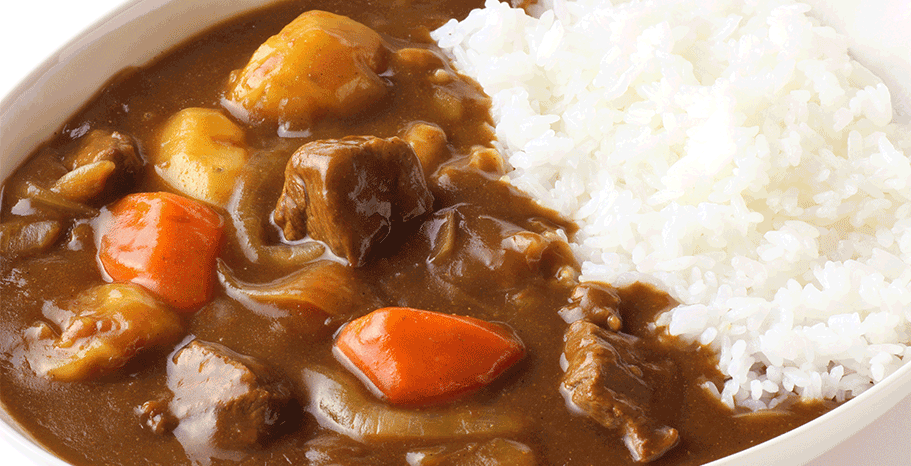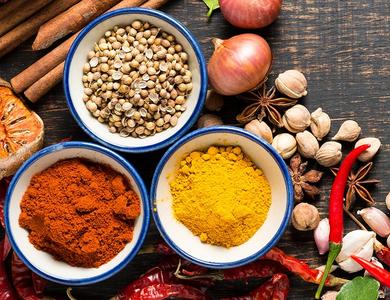
All About Japanese Curry
Everything you need to know about why Japanese curry is so special.
During summertime, many people in Japan enjoy hot and spicy food because they believe spices help cool you down by making you perspire, while building an appetite to fight the sweltering weather. Because of this, many people turn to Japanese curry -- the perfect spicy dish!
Made from rice, curry sauce, and a wide variety of vegetables and meat, it is commonly served in three main forms: curry rice, karē udon (thick noodles) and karē-pan (bread). The basic vegetables used in the dish are onions, carrots and potatoes. Various curry dishes can contain chicken, pork, beef, and seafood.
Japanese curry can be served in anything from a soup bowl to a simple flat plate. It is normally poured over rice that is already in the center of the dish. Curry on rice can be considered a national dish, similar to ramen noodles. Because curry goes so well with rice, a staple food in Japan, it is a favorite dish in nearly every Japanese home and school kitchen.
History of Japanese Curry
The roots of Japanese curry can be found in masala, an Indian spice blend. Cooking with curry originated in India, which at the time was under the administration of the British. The British brought this spice blend back to England, where it eventually became curry powder. This then made its way to Japan in the first half of the 19th century during a period of time known as the Meiji era, and Japanese curry was born.
In Japan, it is common to start with curry roux when preparing curry at home. Roux is made by slowly cooking a mixture of flour, oil, seasonings, spices, and other ingredients until it is reduced (concentrated by cooking off most of the moisture). It is then formed into blocks for use in making curry. The use of curry roux makes it possible to easily prepare a perfect pot of curry every time.
(Note: Roux is a French word for flour and fat, butter, or oil that is sautéed together to make a paste used to thicken sauces, soups, and other dishes.)
What Makes House Foods Curry Different
Curry was originally a spicy dish that was only suitable for adults’ palate. We wanted to create a version that children could enjoy enjoy too, thus the creation for House Vermont Curry was born. House Vermont Curry is a mild roux that preserves the distinctive flavor, aroma, and color of curry, while dialing back the spiciness that make it unsuitable for children. The origin of "Vermont" in Vermont Curry dates back to a book entitled "Folk Medicine: A Vermont Doctor's Guide to Good Health." The book sparked a health fad that included drinking a mixture of apple cider vinegar and honey. This eventually found its way to Japan, sparking a health fad there that came to be known as the "Vermont Health System."
Our Curry is Out Of This World Delicious!
Along with providing people here on Earth with curry, we've taken things a step further by developing "Space Curry." Space Curry was developed in Japan for the astronauts living on the International Space Station. This special curry contains a higher calcium content and spicier flavor than the Earth-bound varieties. Space Curry has been approved by the Japan Aerospace Exploration Agency (JAXA).

Savory, spice, and everything nice.
Curry is widely considered a precious and nutritious health food because of the below spices. These spices are used in a traditional system of Indian medicine called Ayurveda, or Life Sciences, which incorporates them into a daily routine to assure a long and healthy life. People from India commonly use more than 20 different spices in their everyday cooking as they follow a holistic principle of Ayurvedic medicine: "A healthy diet will promote wellness and balance for the body, mind, and spirit."
Curry sauce is made up of many spices that may aid with benefits such as:
Cardamom: improve appetite, relieves flatulence, and induce sweating
Turmeric: aid in increasing liver function, healing fatigue, and acting as an anticancer agent
Cumin: improve appetite and digestion
Black pepper: stimulate appetite, digestion, and circulation
Coriander: help purify the blood, induce sweating, and aid in digestion
Red pepper: help to improve heart and circulation, as well as induce sweating
Cinnamon: can act as a stimulant and detoxifier
Nutmeg: has analgesic effects and may aid in sleep
Fenugreek: has been known to bring down fevers and help with acid indigestion
Bay leaf: contribute to good digestion

